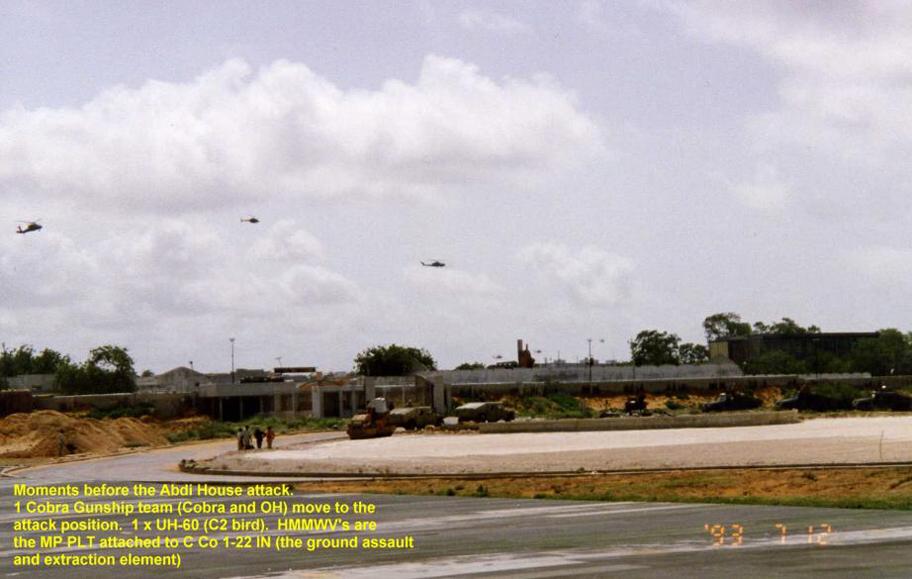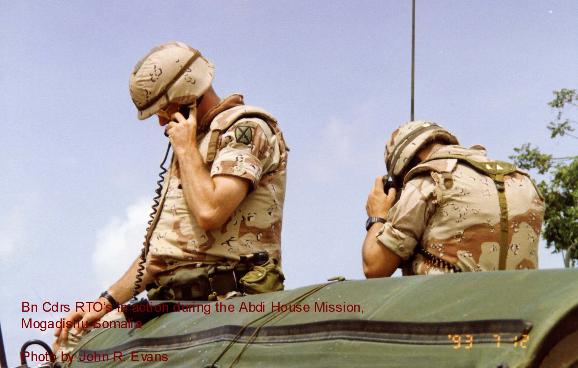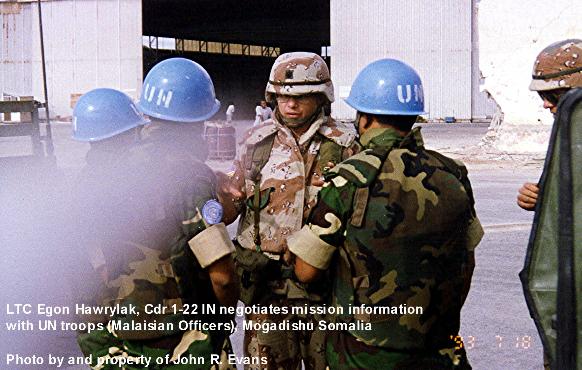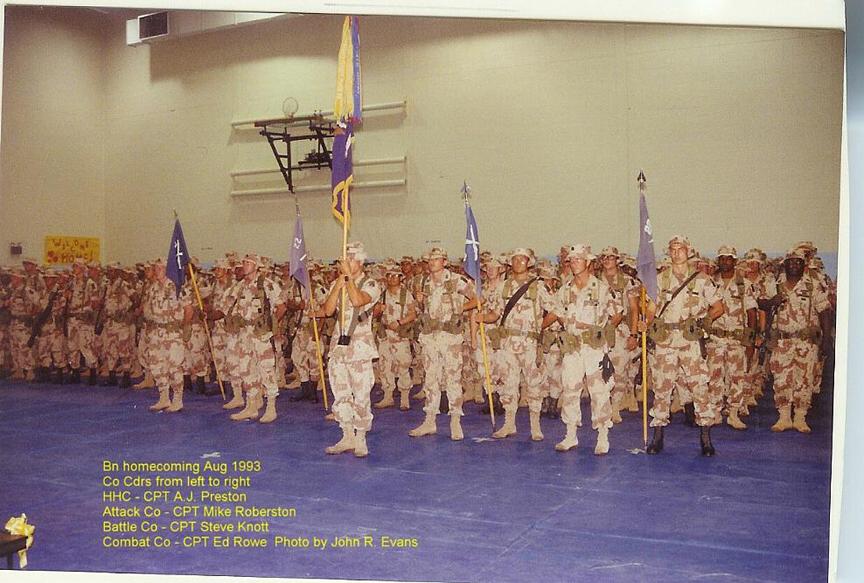![]() 1st Battalion 22nd Infantry
1st Battalion 22nd Infantry ![]()
TF 1-22 Infantry on the Horn of Africa:
OPERATIONS CONTINUE AND RESTORE HOPE -- SOMALIA
Edited from TF 1-22 Infantry, from Homestead to Port au Prince
By MAJ John R. Evans, Command and General Staff College, 2000
Part Four

1-22 IN moves in for the attack on the Abdi House,
July 12, 1993
One last momentous mission was given to the
Battalion in early July that was more significant for the unit
and stemmed, it was thought,
directly from the "snatch" mission. This mission was
fluid from the start, as its intent was again to attack and
capture as many of Aidid's lieutenants
as possible, or even Aidid himself. The events that led up to the
attack of 12 July 93 began with detailed planning on 7 July 1993.
The target location was the Abdi house. Abdi Hassan Awale was
believed to be using his house
to conduct high-level meetings of the Aidid clan and the SNA.
Because only Human Intelligence (HUMINT) from
an inside source could alert the forces of the impending
meetings, the team built to conduct the mission
was on a 30-minute warning string to react to the gathering. The
team was built around the Battalion's "Attack" Company.
A reinforced platoon and the company headquarters formed the
assault force. The other two rifle platoons from A Company
along with the MP Platoon from the Battalion made up the support
by fire platoons and the cordon force.
To round out the package, two Black Hawks from the Aviation
Battalion provided airborne C2 for the Battalion and Brigade
Commanders.
The final piece of the Battalion supporting the assault company
was a ground convoy that consisted of a reinforcing rifle company
(Charlie Company, nicknamed "Combat") and the Battalion
TAC. From its assembly areas within the Enbassy Compound,
Charlie Company was poised to launch via ground convoy to the
Abdi house.
The Charlie Company mission was either to assist or to extract
Alpha Company, as necessary.
Intelligence sources inside the clan that worked for the UN Headquarters gave notice that a meeting was to take place at the Abdi house the morning of 12 July 1993. The battalion was notified and had the attack team in place by 0955 hours. At 1018 hours, after confirmation of the target, six Cobra gun ships fired sixteen TOW missiles into the Abdi House; 30-millimeter chain guns were also used to great effect. Each of the Cobras continued to fire TOW and chain gun rounds into the house until approximately 1022 hours. One minute later, three Black Hawk Helicopters landed in the vicinity of the destroyed house. One bird, containing the support-by-fire platoon, charged with supporting the assault platoon, landed on the French Embassy roof, which provided excellent cover and observation of the Abdi house. Two other Black Hawks, with elements of the other two rifle platoons, landed among the rubble in the street in front of the Abdi house. Simultaneously, a cordon force of the remaining A Company elements and the MP platoon constructed a cordon around the house. One of the two platoons that landed in the street provided close security for the assault platoon as it made its way from the street into the compound and the house to search for surviving SNA leadership and any valuable intelligence.

BN Commander's RTO's in action during the Abdi House
Mission, July 12, 1993
By 1035 hours, the raid was completed and all elements were enroute back to the base camp. The raid did not result in any captured SNA leaders or intelligence documents, but it did signify another major change in focus for the QRF. Somali casualty figures vary by account, but the numbers were significant. The casualty report from the commander of 1-22 Infantry to higher headquarters was: “in total 13 Somali killed in action (KIA) and 7 WIA from the raid. Later Aidid claimed that we killed over 70 Somali.” That UN attack conducted by the First Brigade may have been the final straw that led up to the ambush of the Ranger battalion in October of 1993. As an SNA leader recounted the 12 July attacks in Bowden’s Black Hawk Down:
“It
was one thing for the world to intervene to feed the starving,
and even for the U.N. to help Somalia form a peaceful government.
But this business of sending in U.S. Rangers swooping down into
their city killing and kidnapping their leaders, this was just
too much”.
In actuality, the “rangers” that the SNA leader talks of during the attack on the Abdi house in July 1993 were soldiers from 1-22 Infantry.
This foreboding and foreshadowing quote was further highlighted by retired Admiral Jonathan Howe, former special representative of the UN Secretary General to Somalia, as he outlined the evolvement of the QRF in Somalia:
“The United States also maintained its Army QRF force in Somalia for longer than originally envisaged and used it more extensively. Although small in size and restricted in what it was authorized to do, the very capable QRF became, nonetheless, the backbone of the UN force during the period of organized hostilities.”
Transition
With the completion of the Abdi house mission, offensive combat operations were over for 1-22 Infantry. On 13 July 93, Lieutenant Colonel Martinez was officially notified that the battalion change of command would take place two days later. Additionally, he was notified that the battalion was to be relieved by the 2nd Battalion, 14th Infantry, from the second brigade and that 1-22 Infantry would redeploy on 12 August 1993.

LTC Egon Hawrylak speaks with fellow UN Officers, July 18. 1993
LTC Hawrylak assumed command of 1-22 IN on July 15, 1993.
Upon notification that 2-14 Infantry would backfill the battalion, initial coordination and planning for the event began immediately. The transition plan was predicated on the previous experiences of relief in place operations that occurred with 2-87 Infantry and the Pakistani battalion at Marka.
Redeployment occurred on 13 August 1993 with one last convoy from the University Compound to the Mogadishu airport, where the battalion boarded a Tiger Air 747 and flew back to Griffis Air Force Base.
Once redeployed to Ft Drum New York, the battalion’s qualified infantrymen and medics were awarded Combat Infantry and Combat Medic Badges. The battalion was also awarded a Somali Campaign Ribbon for the Regimental Colors, and a Joint Meritorious Unit Award.

1-22 IN homecoming - Fort Drum, August 1993

Joint Meritorious Unit Citation awarded to 1-22 Infantry
for its service in Somalia
Text and photos copyright © John R. Evans 2005
Home | Photos | Battles & History | Current |
Rosters & Reports | Medal of Honor | Killed
in Action |
Personnel Locator | Commanders | Station
List | Campaigns |
Honors | Insignia & Memorabilia | 4-42
Artillery | Taps |
What's New | Editorial | Links |